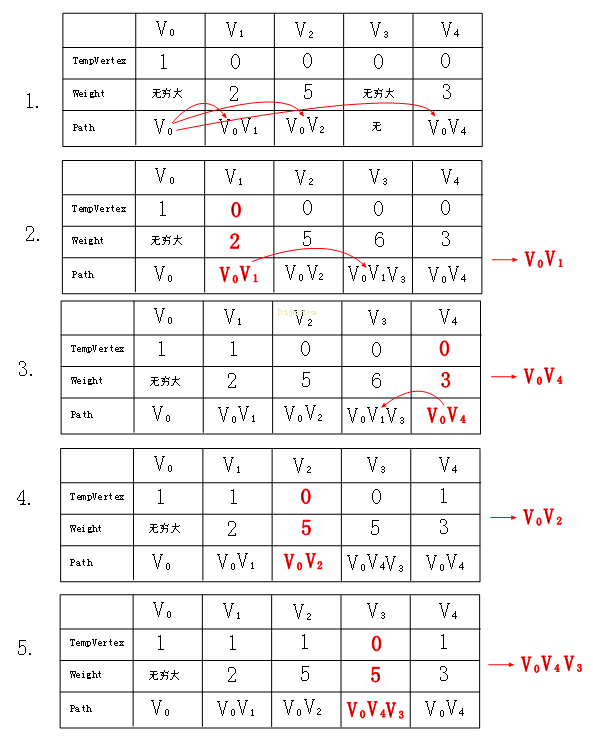或许在生活中,经常会碰到针对某一个问题,在众多的限制条件下,如何去寻找一个最优解?可能大家想到了很多诸如“线性规划”,“动态规划”
这些经典策略,当然有的问题我们可以用贪心来寻求整体最优解,在图论中一个典型的贪心法求最优解的例子就莫过于“最短路径”的问题。
一:概序
从下图中我要寻找V0到V3的最短路径,你会发现通往他们的两点路径有很多:V0->V4->V3,V0->V1->V3,当然你会认为前者是你要找的最短
路径,那如果说图的顶点非常多,你还会这么轻易的找到吗?下面我们就要将刚才我们那点贪心的思维系统的整理下。

二:构建
如果大家已经了解Prim算法,那么Dijkstra算法只是在它的上面延伸了下,其实也是很简单的。
1.边节点
这里有点不一样的地方就是我在边上面定义一个vertexs来记录贪心搜索到某一个节点时曾经走过的节点,比如从V0贪心搜索到V3时,我们V3
的vertexs可能存放着V0,V4,V3这些曾今走过的节点,或许最后这三个节点就是我们要寻找的最短路径。
1 #region 边的信息
2 /// <summary>
3 /// 边的信息
4 /// </summary>
5 public class Edge
6 {
7 //开始边
8 public int startEdge;
9
10 //结束边
11 public int endEdge;
12
13 //权重
14 public int weight;
15
16 //是否使用
17 public bool isUse;
18
19 //累计顶点
20 public HashSet<int> vertexs = new HashSet<int>();
21 }
22 #endregion
2.Dijkstra算法

首先我们分析下Dijkstra算法的步骤:
有集合M={V0,V1,V2,V3,V4}这样5个元素,我们用
TempVertex表示该顶点是否使用。
Weight表示该Path的权重(默认都为MaxValue)。
Path表示该顶点的总权重。
①. 从集合M中挑选顶点V0为起始点。给V0的所有邻接点赋值,要赋值的前提是要赋值的weight要小于原始的weight,并且排除已经访问过
的顶点,然后挑选当前最小的weight作为下一次贪心搜索的起点,就这样V0V1为挑选为最短路径,如图2。
②. 我们继续从V1这个顶点开始给邻接点以同样的方式赋值,最后我们发现V0V4为最短路径。也就是图3。
。。。
③. 最后所有顶点的最短路径就这样求出来了 。
1 #region Dijkstra算法
2 /// <summary>
3 /// Dijkstra算法
4 /// </summary>
5 public Dictionary<int, Edge> Dijkstra()
6 {
7 //收集顶点的相邻边
8 Dictionary<int, Edge> dic_edges = new Dictionary<int, Edge>();
9
10 //weight=MaxValue:标识没有边
11 for (int i = 0; i < graph.vertexsNum; i++)
12 {
13 //起始边
14 var startEdge = i;
15
16 dic_edges.Add(startEdge, new Edge() { weight = int.MaxValue });
17 }
18
19 //取第一个顶点
20 var start = 0;
21
22 for (int i = 0; i < graph.vertexsNum; i++)
23 {
24 //标记该顶点已经使用过
25 dic_edges[start].isUse = true;
26
27 for (int j = 1; j < graph.vertexsNum; j++)
28 {
29 var end = j;
30
31 //取到相邻边的权重
32 var weight = graph.edges[start, end];
33
34 //赋较小的权重
35 if (weight < dic_edges[end].weight)
36 {
37 //与上一个顶点的权值累加
38 var totalweight = dic_edges[start].weight == int.MaxValue ? weight : dic_edges[start].weight + weight;
39
40 if (totalweight < dic_edges[end].weight)
41 {
42 //将该顶点的相邻边加入到集合中
43 dic_edges[end] = new Edge()
44 {
45 startEdge = start,
46 endEdge = end,
47 weight = totalweight
48 };
49
50 //将上一个边的节点的vertex累加
51 dic_edges[end].vertexs = new HashSet<int>(dic_edges[start].vertexs);
52
53 dic_edges[end].vertexs.Add(start);
54 dic_edges[end].vertexs.Add(end);
55 }
56 }
57 }
58
59 var min = int.MaxValue;
60
61 //下一个进行比较的顶点
62 int minkey = 0;
63
64 //取start邻接边中的最小值
65 foreach (var key in dic_edges.Keys)
66 {
67 //取当前 最小的 key(使用过的除外)
68 if (min > dic_edges[key].weight && !dic_edges[key].isUse)
69 {
70 min = dic_edges[key].weight;
71 minkey = key;
72 }
73 }
74
75 //从邻接边的顶点再开始找
76 start = minkey;
77 }
78
79 return dic_edges;
80 }
81 #endregion
总的代码:复杂度很烂O(N2)。。。
using System;
using System.Collections.Generic;
using System.Linq;
using System.Text;
using System.Diagnostics;
using System.Threading;
using System.IO;
using System.Threading.Tasks;
namespace ConsoleApplication2
{
public class Program
{
public static void Main()
{
Dictionary<int, string> dic = new Dictionary<int, string>();
MatrixGraph graph = new MatrixGraph();
graph.Build();
var result = graph.Dijkstra();
Console.WriteLine("各节点的最短路径为:");
foreach (var key in result.Keys)
{
Console.WriteLine("{0}", string.Join("->", result[key].vertexs));
}
Console.Read();
}
}
#region 定义矩阵节点
/// <summary>
/// 定义矩阵节点
/// </summary>
public class MatrixGraph
{
Graph graph = new Graph();
public class Graph
{
/// <summary>
/// 顶点信息
/// </summary>
public int[] vertexs;
/// <summary>
/// 边的条数
/// </summary>
public int[,] edges;
/// <summary>
/// 顶点个数
/// </summary>
public int vertexsNum;
/// <summary>
/// 边的个数
/// </summary>
public int edgesNum;
}
#region 矩阵的构建
/// <summary>
/// 矩阵的构建
/// </summary>
public void Build()
{
//顶点数
graph.vertexsNum = 5;
//边数
graph.edgesNum = 6;
graph.vertexs = new int[graph.vertexsNum];
graph.edges = new int[graph.vertexsNum, graph.vertexsNum];
//构建二维数组
for (int i = 0; i < graph.vertexsNum; i++)
{
//顶点
graph.vertexs[i] = i;
for (int j = 0; j < graph.vertexsNum; j++)
{
graph.edges[i, j] = int.MaxValue;
}
}
//定义 6 条边
graph.edges[0, 1] = graph.edges[1, 0] = 2;
graph.edges[0, 2] = graph.edges[2, 0] = 5;
graph.edges[0, 4] = graph.edges[4, 0] = 3;
graph.edges[1, 3] = graph.edges[3, 1] = 4;
graph.edges[2, 4] = graph.edges[4, 2] = 5;
graph.edges[3, 4] = graph.edges[4, 3] = 2;
}
#endregion
#region 边的信息
/// <summary>
/// 边的信息
/// </summary>
public class Edge
{
//开始边
public int startEdge;
//结束边
public int endEdge;
//权重
public int weight;
//是否使用
public bool isUse;
//累计顶点
public HashSet<int> vertexs = new HashSet<int>();
}
#endregion
#region Dijkstra算法
/// <summary>
/// Dijkstra算法
/// </summary>
public Dictionary<int, Edge> Dijkstra()
{
//收集顶点的相邻边
Dictionary<int, Edge> dic_edges = new Dictionary<int, Edge>();
//weight=MaxValue:标识没有边
for (int i = 0; i < graph.vertexsNum; i++)
{
//起始边
var startEdge = i;
dic_edges.Add(startEdge, new Edge() { weight = int.MaxValue });
}
//取第一个顶点
var start = 0;
for (int i = 0; i < graph.vertexsNum; i++)
{
//标记该顶点已经使用过
dic_edges[start].isUse = true;
for (int j = 1; j < graph.vertexsNum; j++)
{
var end = j;
//取到相邻边的权重
var weight = graph.edges[start, end];
//赋较小的权重
if (weight < dic_edges[end].weight)
{
//与上一个顶点的权值累加
var totalweight = dic_edges[start].weight == int.MaxValue ? weight : dic_edges[start].weight + weight;
if (totalweight < dic_edges[end].weight)
{
//将该顶点的相邻边加入到集合中
dic_edges[end] = new Edge()
{
startEdge = start,
endEdge = end,
weight = totalweight
};
//将上一个边的节点的vertex累加
dic_edges[end].vertexs = new HashSet<int>(dic_edges[start].vertexs);
dic_edges[end].vertexs.Add(start);
dic_edges[end].vertexs.Add(end);
}
}
}
var min = int.MaxValue;
//下一个进行比较的顶点
int minkey = 0;
//取start邻接边中的最小值
foreach (var key in dic_edges.Keys)
{
//取当前 最小的 key(使用过的除外)
if (min > dic_edges[key].weight && !dic_edges[key].isUse)
{
min = dic_edges[key].weight;
minkey = key;
}
}
//从邻接边的顶点再开始找
start = minkey;
}
return dic_edges;
}
#endregion
}
#endregion
}
